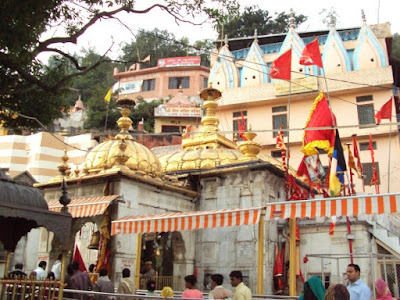 |
| Temple |
Jwala ji temple in Himachal Pradesh
Description
 |
| Jwala Ji Flame |
Jwala ji (flame) or Jwala Mukhi (flame mouth) is probably the most ancient temple discussed here besides Vaishno Devi. It is mentioned in the Mahabharata and other scriptures. There is a natural cave where eternal flames continue to burn. Some say there are nine flames for the nine Durgas ... Several schools of Buddhism also share the symbolism of a seven-forked sacred flame.
Jwala Ji Kangra
The best known
Jwala shrine is located in the lower Himalayas
in Jwalamukhi town of the Kangra district of Himachal Pradesh state of India, about 55 kilometers from the larger town of Dharamsala The temple style is typical of Jwala Ji shrines, four cornered, with a small dome on the top and a square central pit of hollowed stone inside where the main flame burns endlessly. An annual fair is held in the environs of the temple every July/August months during Navratars Maa JwalaMukhi is family Goddess or Kuldevi of Gujrals and Bhatias. The temple had an associated library of ancient Hindu texts, many of which were translated from Sanskrit into Persian at the orders of Firoz shah Tuglak with Legendary the Delhi Sultanate overran the Kangra area. According to the legend, when Sati's body was divided into 51 parts, Sati Mata's tongue fell here. The flames/ Jyotis are the representation of the same. Some say that Sati's clothes fell here. When they fell they were on fire. The fire hasn't blew off.
Jwalaji (flame) or Jwala Mukhi (flame mouth) is probably the most ancient temple discussed here besides Vaishno Devi. It is mentioned in the
Mahabharata and other scriptures. There is a natural cave where eternal flames continue to burn. Some say there are seven or nine flames for the seven divine sisters or the nine Durgas. It is here that Sati's tongue fell which can now be seen in the form of the flame.
 |
| Himalayas Temple |
The Legend
Ancient legends speak of a time when demons lorded over the Himalaya mountains and harassed the gods. Led by Lord Vishnu, the gods decided to destroy them. They focused their strengths and huge flames rose from the ground. From that fire, a young girl took birth. She is regarded as Adishakti-the first 'shakti'.
Known as Sati or Parvati, she grew up in the house of Prajapatii Daksha and later, became the consort of Lord Shiva. Once her father insulted Lord Shiva and unable to accept this, she killed herself. When Lord Shiva heard of his wife’s death his rage knew no bounds and holding Sati’s body he began stalking the three worlds. The other gods trembled before his wrath and appealed to Lord Vishnu for help. Lord Vishnu let fly a volley of arrows which struck Sati’s body and severed it to pieces. At the places where the pieces fell, the fifty-one sacred 'shaktipeeths' came into being. "Sati’s tongue fell at Jawalaji (610 m) and the goddess is manifest as tiny flames that burn flawless blue through fissures in the age-old rock".
Jawalamukhi has been a pilgrimage center for many years. The mughal
Emperor Akbar once tried to extinguish the flames by covering them with an iron disk and even channelizing water to them. But the flames blasted all these efforts. Akbar then presented a golden parasol (ch attar) at the shrine. However, his cynicism at the power of devi caused the gold to debase into another metal which is still unknown to the world. His belief in the deity was all the more strengthened after this incident. Thousands of pilgrims visit the shrine round the year to satisfy their spiritual urge.
Jwala Devi of Shakti Nagar
 |
| Shaktipeeth |
Jwala is in Shaktinagar township in Sonbhadra uttar pradesh . This is an old age Ashtagrih temple of Jwala Devi & one of the 51 Shaktipeethas of India. The old temple is believed to be 1000 years old. The old temple was constructed by Raja Udit Narayan Narayan Singh of Gaharwal. The new temple has been built replacing the old one. Here the tongue of Parvati is worshiped. The Idol of the main deity is located in the Sanctum Sanatorium (central place of the temple). The old black stone idol which was in the old temple has been installed along with other deities surrounding the main idol. It is believed that people offer their tongue as offerings here after their wishes are fulfilled.
Jwala Mai Of Mukhti Nath
 |
| Murti |
The "eternal flame" at the Jwala Ji shrine in the village of mukti Nath is located at an altitude of 3,710 meters at the foot of theThorong La mountain pass in the Mustang District of Nepal. There is a small amount of natural gas present in the Himalayas spring that emerges near the shrine which gives the appearance of the fire burning on the water itself. This shrine is usually called the Jwala Mai (Jwala Mother) temple, and is sacred to both Hindus and Buddhists.






Comments
Post a Comment